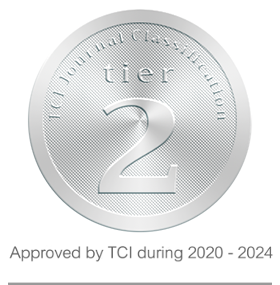Effect of Substrate Media on Growth and Yield of Chinese Kale in Pot
Keywords:
waste material, bio-sludge, coffee bean husks, coffee groundsAbstract
Chinese Kale (Brassica alboglabra L.) is an important economic vegetable that is demanded by both domestic and international consumers increasing every year. Suitable substrate medias have light weight, nutrients suitable for growth and easy to find locally. So that, this experiment was to study the effects of substrate media on the growth and yield of potted Chinese Kale at the Faculty of Agricultural Technology, Songkhla Rajabhat University during October 2021 to February 2022. Completely randomized design (CRD) was designed to include five replications and used six different growing mediums for comparison: i) Formula 1 (coffee grounds: chicken manure: top soil in the volume ratio of 1:1:4), ii) Formula 2 (coffee grounds: bio-sludge: top soil in the volume ratio of 1:1:4), iii) formula 3 (coffee bean husks: chicken manure: top soil in the volume ratio of 1:1:4), iv) formula 4 (coffee bean husks: bio-sludge: top soil in the volume ratio of 1:1:4), v) formula 5 (coffee grounds: coffee bean husks: chicken manure: bio-sludge: top soil in the volume ratio of 0.5:0.5:0.5:0.5:4) and vi) commercial formula (control). The study revealed that the formula 1 mixture provided the best results, generating a mean figure of plant height (10.73 cm), number of leaves (9.33 leaves/plant), canopy width (29.50 cm), fresh weight (52.00 g/plant) showed the significant difference. Therefore, mixing coffee grounds and chicken manure with top soil can be used as a potting material to promote growth and increase yields of vegetables.
References
Arworn, P. and Chavalparit. O. 2012. Utilization of bio-sludge from olefin wastewater treatment plant as co-composting material. Proceedings of the 9th Kasetsart University Kamphaeng Saen Campus Conference: Engineering, Science Technology and Environment,
Nakhon Pathom, Thailand 6-7 December 2012, pp. 17-24. (In Thai with English Abstract)
Carlile, W.R. 2008. The use of composted materials in growing media. Acta Horticulturae 779: 857-864.
Cherdboonchart, V. 2002. Growing Thai Vegetables for Both Food and Medicine. 2nd edition. Bangkok: House and garden. (In Thai)
Chrysargyris, A., Antoniou, O., Xylia, P., Petropoulos, S., and Tzortzakis, N. 2020. The use of spent coffee grounds in growing media for the production of Brassica seedlings in nurseries. Environmental Science and Pollution Research 28(19): 24279-24290.
Chumthong, A. and Pakdeechanuan, P. 2019. Effects of bioextract accelerates the decomposition of rice straw on growth of rice variety Ruang Ree. Songklanakarin Journal of Plant Science 6(1): 82-90. (In Thai with English Abstract)
Department of Land Development. 2015. Handbook of Land Development for volunteered soil doctor and farmers. Ministry of Agriculture and Cooperatives. (In Thai)
Duangpatra, P. 2013. Soil Amendment. Department of Soil Science, Faculty of Agriculture, Kasetsart University. (In Thai)
Hardgrove, S. J., and Livesley, S. J. 2016. Applying spent coffee grounds directly to urban agriculture soils greatly reduces plant growth. Urban Forestry & Urban Greening 18: 1-8.
Khasa, D.P., Fung, M. and Logan, N.B. 2005. Early growth response of container frown selected woody boreal seedling in amended composite talling and sand. Bioresource Technology 96(7): 857-864.
Lesing, S. and Anugoolprasert, O. 2016. Efficacy of high quality organic fertilizer on growth and yield of Chinese Kale. Journal of Science and Technology 24(2): 320-332. (In Thai with English Abstract)
Mussatto, S.I., Carneiro, L.M., Silva, J.P., Roberto, I.C. and Teixeira, J.A. 2011. A study on chemical constituents and sugars extraction from spent coffee grounds. Carbohydrate Polymers 83(2): 368- 374.
Nonthakit, I. 2012. Planting in Medias. Department of Soil Science. Faculty of Agricultural Technology. King Monkut’s Institute of Technology Ladkrabang. Bangkok. (In Thai)
Soil Analysis Division. 1997. Soil Physical and Chemical Properties in Laboratory Soil Analysis. Department of Land Development, Bangkok. (In Thai)
Somrug, K. 2017. Effects of indigo sludge compost on growth and yield of Chinese Kale (Brassica alboglabra). Prawarun Agricultural Journal 14(2): 165-172. (In Thai with English Abstract)
Sooksawat, M. 2004. Agricultural Handbook: Flower and Ornamental Medias. Bangkok: House and garden, pp. 11-13. (In Thai)
Supinrach, S., Supinrach, I. and Sriwanchai, R. 2016. Effect of media on growth and flowering of China Pink (Dianthus chinensis). Sonklanakarin Journal of Plant Science 3 (Suppl. (II)): M044/77-82.
Supinrach. S. and Supinrach, I. 2018. Effect of substrate media on growth performance of leaf lettuce. Agricultural Science Journal 49 (Suppl.): 47-52. (In Thai with English Abstract)
Verkerk, R., Schreiner, M., Krumbein, A., Ciska, E., Holst, B., Rowland, I., de Schrijver, R., Hansen, M., Gerhuser, C., Mithen, R. and Dekker, M. 2009. Glucosinolates in Brassica vegetables: The influence of the food supply chain on intake, bio availability and human health. Molecular Nutrition & Food Research 53: 219-265.
Yamane, K., Kono, M., Fukunaga, T., Iwai, K., Sekine, R., Watanabe, Y., and Iijima, M. 2014. Field evaluation of coffee grounds application for crop growth enhancement, weed control, and soil improvement. Plant Production Science 17(1): 93-102.
Downloads
Published
How to Cite
Issue
Section
License

This work is licensed under a Creative Commons Attribution-NonCommercial-NoDerivatives 4.0 International License.



